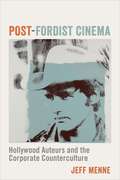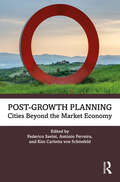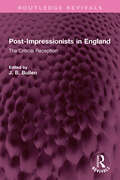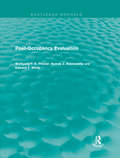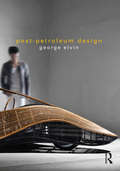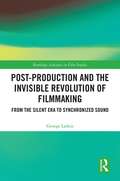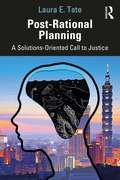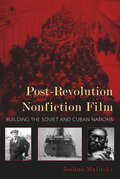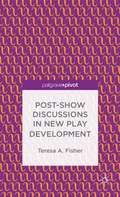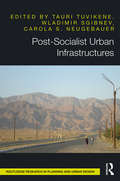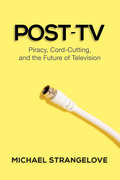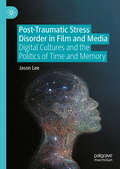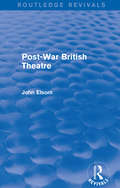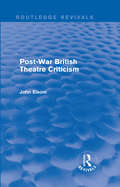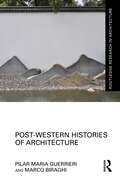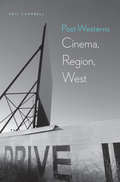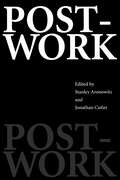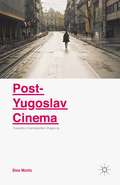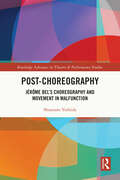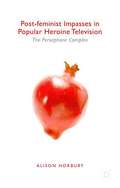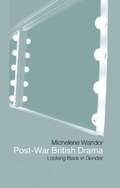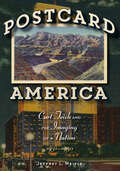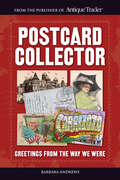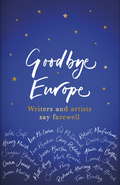- Table View
- List View
Post-Fordist Cinema: Hollywood Auteurs and the Corporate Counterculture (Film and Culture Series)
by Jeff MenneThe New Hollywood boom of the late 1960s and 1970s is celebrated as a time when maverick directors bucked the system. Against the backdrop of counterculture sensibilities and the prominence of auteur theory, New Hollywood directors such as Robert Altman and Francis Ford Coppola seemed to embody creative individualism. In Post-Fordist Cinema, Jeff Menne rewrites the history of this period, arguing that auteur theory served to reconcile directors to Hollywood’s corporate project.Menne traces the surprising affinities between auteur theory and management gurus such as Peter Drucker, who envisioned a more open and flexible corporate style. In founding production companies, New Hollywood filmmakers took part in the creation of new corporate models that emphasized entrepreneurial creativity. For firms such as Kirk Douglas’s Bryna Productions, Altman’s Lion’s Gate Films, the Zanuck-Brown Company, and BBS Productions, the counterculture ethos limbered up the studio system’s sclerotic production process—with striking parallels to how management theory conceived of the role of the individual within the firm. Menne offers insightful readings of how films such as Lonely Are the Brave, Brewster McCloud, Jaws, and The King of Marvin Gardens narrate the conditions in which they were created, depicting shifting notions of work and corporate structure. While auteur theory allowed directors to cast themselves as independent creators, Menne argues that its most consequential impact came as a management doctrine. An ambitious rethinking of New Hollywood, Post-Fordist Cinema sheds new light on the cultural myth of the great director and the birth of the “creative economy.”
Post-Growth Planning: Cities Beyond the Market Economy
by Federico SaviniThis book draws on a wide range of conceptual and empirical materials to identify and examine planning and policy approaches that move beyond the imperative of perpetual economic growth. It sketches out a path towards planning theories and practices that can break the cyclical process of urban expansion, crises, and recovery that negatively affect ecosystems and human lives. To reduce the dramatic social and environmental impact of urbanization, this book offers both a critique of growth-led urban development and a prefiguration of ecologically regenerative and socially just ways of organizing cities and regions. It uncovers emerging possibilities for post-growth planning in the fields of collective housing, mobility, urban commoning, ecological land-use, urban–rural symbiosis, and alternative planning worldviews. It provides a toolkit of concepts and real-life examples for urban scholars, urbanists, activists, architects, and designers seeking to make cities prosper within planetary boundaries. This book speaks to both experts and beginners in post-growth thinking. It concludes with a manifesto and glossary of key terms for urban scholars, students, and practitioners.
Post-Impressionists in England: The Critical Reception (Routledge Revivals)
by J. B. BullenFirst Published in 1988, Post-impressionists in England documents the response of English taste to modern French art from the first Post-Impressionist Exhibition in 1910 to the outbreak of the First World War. The notion of ‘Post-Impressionism’, unlike its earlier counterpart, Impressionism, was an exclusively English contribution to art history. Originally used to denote the work of Cezanne, Van Gogh, Gauguin, Matisse and the Fauve painters, it rapidly assimilated Futurism, Cubism and recent English work like Vorticism. By focusing on one aspect of an important and complex period in British cultural history, J.B. Bullen illuminates not only aesthetic questions but also the way in which those aesthetic issues were determined and conditioned by social and political concerns.Changes in English attitudes to art in this period were so rapid and were modified with such speed that the author has taken a strictly chronological approach to the subject. He sets out clearly the month-by-month developments in English attitudes and traces in detail the debates about modernism in England. To make matters clearer the book is divided into three major parts, each complementary to the others. The introduction surveys the period as a whole and places attitudes to art in the general context of the culture of the time. In the second part the extracts provide selected, concrete and particular examples of the huge range of material upon which the findings of the introduction are based; the writers represented include Roger Fry, Bernard Berenson, Desmond McCarthy, John singer Sargent, Walter Sickert, Clive Bell, Virginia Woolf and Wyndham Lewis. In the third part a chronology sets out in tabular form month-by-month events- exhibitions and major publications- as they occurred in Britain and in France. This is a must read for scholars and researchers of British cultural history and art history.
Post-Occupancy Evaluation (Routledge Revivals)
by Edward White Wolfgang F. Preiser Harvey RabinowitzPost-occupancy evaluation, focusing on building’s occupants and their needs, provides insight into the consequences of past design decisions and forms a sound basis for creating better buildings in the future. This book, first published in 1988, includes a review of the evolution of the field, a conceptual frame-work for POE, and pragmatic information on planning, conducting, and reporting POEs. Post-Occupancy Evaluation categorizes the approaches to building evaluation by describing the three levels of POE effort – indicative, investigative, and diagnostic, each differing in terms of time, resources, and personnel needed. In its scope Post-Occupancy Evaluation is both comprehensive and specific; professionals in the design and planning disciplines will find it an invaluable resource for understanding the theory behind POE’s and the procedures needed to put the theory into practice.
Post-Petroleum Design
by George ElvinDespite the growing demand for design strategies to reduce our petroleum use, no one has yet brought together the lessons of the world’s leading post-petroleum designers into a single resource. Post-Petroleum Design brings them together for the first time. Readers will be introduced to the most current, innovative, plastic-and petroleum-free products and projects in industrial design, architecture, transportation, electronics, apparel and more. Post-Petroleum Design explores firsthand the client and consumer motivations behind the demand, and shares the case studies, principles, best practices, risks and opportunities of the world’s leading post-petroleum design experts who are already meeting that demand. It introduces 40 inspiring individuals from across the globe; people like Eben Bayer, the American innovator whose company, Ecovative, is growing houses from mushrooms; Mohammed Bah Abba, whose Zeer Pot is helping families keep produce fresh in the sweltering Nigerian summer without electricity; and the engineers at Mercedes-Benz Advanced Design Studios whose Biome car evolves from genetically engineered DNA. Post-Petroleum Design gives design professionals the information they need to research, evaluate, and select materials, technologies and design strategies that meet the growing demand for sustainable design, plastic-free materials and process energy conservation. Designer profiles, studies, statistics and many colour illustrations all highlight the work—some of the best design work to be found anywhere, and showcased here for the first time.
Post-Production and the Invisible Revolution of Filmmaking: From the Silent Era to Synchronized Sound (Routledge Advances in Film Studies)
by George LarkinPost-Production and the Invisible Revolution of Filmmaking studies the discourses surrounding post-production, as well as the aesthetic effects of its introduction during the 1920s and 1930s, by exploring the philosophies and issues faced by practitioners during this transitional, transformative period. The introduction of post-production during the transition from silent cinema to the synchronized sound era in the 1920s American studio system resulted in what has been a previously unheralded and invisible revolution in filmmaking. Thereafter, a film no longer arose from a live and variable combination of audio and visual in the theater, as occurred during the silent film era, where each exhibition was a singular event. The new system of post-production effectively shifted control of a film’s final form from the theater to the editing room. With this new process, filmmakers could obtain and manipulate an array of audio elements and manufacture a permanent soundtrack. This transition made possible a product that could be easily mass-produced, serving both to transform and homogenize film presentation, fundamentally creating a new art form. With detailed research and analysis and nearly 50 illustrations, this book is the ideal resource for students and researchers of film history and post-production.
Post-Rational Planning: A Solutions-Oriented Call to Justice
by Laura E. TatePost-Rational Planning confronts today’s threats to truth, particularly after recent news events that present alternative facts and media smear campaigns, often described as post-truth politics. At the same time, it appreciates critical tensions: between rationality (prized by planners and other policy professionals) and desires for positive, socially just outcomes. Rather than abandoning quests for truth, this book provides planners, policy professionals, and students with tools for better responding to debates over truth. Post-Rational Planning examines planners’ unease with emotion and politics, advocating for more scholarship and practice capable of unpacking uses of rhetoric and framing to support or counter key planning decisions impacting social justice. This includes learning from recent works engaging with rhetoric, narrative construction, and framing in planning, while introducing other valuable concepts from disciplines like psychology, including confirmation bias; identity-protective cognition; from marketing and adult education. Each chapter sheds new light on a specific topic requiring a response through post-rational practice. It starts with recent research findings, then demonstrates them with case examples, enabling their use in classroom and practice settings. Each chapter ends by summarizing key lessons in "Take-aways for Practice," better enabling readers of all levels to synthesize and use key ideas.
Post-Revolution Nonfiction Film: Building the Soviet and Cuban Nations (New Directions in National Cinemas)
by Joshua MalitskyA study of how the state has used documentary films to create historical and political narratives in the Soviet Union and Cuba.In the charged atmosphere of post-revolution, artistic and political forces often join in the effort to reimagine a new national space for a liberated people. Joshua Malitsky examines nonfiction film and nation building to better understand documentary film as a tool used by the state to create powerful historical and political narratives. Drawing on newsreels and documentaries produced in the aftermath of the Russian revolution of 1917 and the Cuban revolution of 1959, Malitsky demonstrates the ability of nonfiction film to help shape the new citizen and unify, edify, and modernize society as a whole. Post-Revolution Nonfiction Film not only presents a critical historical view of the politics, rhetoric, and aesthetics shaping post-revolution Soviet and Cuban culture but also provides a framework for understanding the larger political and cultural implications of documentary and nonfiction film.“A splendid and highly readable book which imbues a suggestive comparison of cinema in the early years of the Soviet and Cuban revolutions with fresh insights.” —Michael Chanan, author of Cuban Cinema“Joshua Malitsky here mines a rich seam. By closely comparing Vertov and Alvarez he uncovers “post-revolutionary nonfiction film” as a discernible entity with commonalities shared across time and cultures. The extensive—indeed vast—archive of newsreels from both filmmakers is well worth the thorough attention he gives it, suggesting a context for their better-known documentaries. And his situating of Esfir Shub’s compilations as not so much an alternative to Vertov but rather a wholesale replacement approach to agitprop is also compelling. All in all, Malitsky offers a crucial corrective to much received thinking on 20th century radical film.” —Brian Winston, University of Lincoln, UK
Post-Show Discussions in New Play Development
by Teresa A. FisherMany theatres host post-show discussions, or talkbacks, as part of their season. This book is a critical examination of what has/has not worked with post-show discussions utilized in new play development, providing a framework for understanding discussions, steps for building the foundation of them, and various strategies for structuring them.
Post-Socialist Urban Infrastructures
by Wladimir Sgibnev Tauri Tuvikene Carola S. NeugebauerPost-Socialist Urban Infrastructures critically elaborates on often forgotten, but some of the most essential, aspects of contemporary urban life, namely infrastructures, and links them to a discussion of post-socialist transformation. As the skeletons of cities, infrastructures capture the ways in which urban environments are assembled and urban lives unfold. Focusing on post-socialist cities, marked by neoliberalisation, polarisation and hybridity, this book offers new and enriching perspectives on urban infrastructures by centering on the often marginalised aspects of urban research—transport, green spaces, and water and heating provision. Featuring cases from West and East alike, the book covers examples from Azerbaijan, Bulgaria, Serbia, Croatia, Germany, Russia, Georgia, Lithuania, Poland, the Czech Republic, Tajikistan, and India. It provides original insights into the infrastructural back end of post-socialist cities for scholars, planners and activists interested in urban geography, cultural and social anthropology, and urban studies.
Post-TV
by Michael StrangeloveIn the late 2000s, television no longer referred to an object to be watched; it had transformed into content to be streamed, downloaded, and shared. Tens of millions of viewers have "cut the cord," abandoned cable television, tuned into online services like Netflix, Hulu, and YouTube, and also watch pirated movies and programmes at an unprecedented rate. The idea that the Internet will devastate the television and film industry in the same way that it gutted the music industry no longer seems farfetched. The television industry, however, remains driven by outmoded market-based business models that ignore audience behaviour and preferences.In Post-TV, Michael Strangelove explores the viewing habits and values of the post-television generation, one that finds new ways to exploit technology to find its entertainment for free, rather than for a fee. Challenging the notion that the audience is constrained by regulatory and industrial regimes, Strangelove argues that cord-cutting, digital piracy, increased competition, and new modes of production and distribution are making audiences and content more difficult to control, opening up the possibility of a freer, more democratic, media environment.A follow-up to the award-winning Watching YouTube, Post-TV is a lively examination of the social and economic implications of a world where people can watch what they want, when they want, wherever they want.
Post-Traumatic Stress Disorder in Film and Media: Digital Cultures and the Politics of Time and Memory
by Jason LeeThis book expounds how post-traumatic stress disorder (PTSD) became so ubiquitous. The relationships between trauma, memory, and media, including the cultural, psychological, and social dimensions of PTSD are analysed. This work provides an examination of PTSD across diverse cultural contexts, shedding light on its profound impact on human experience and societal structures. This work addresses the role of social media internationally, the pornography industry, and conspiracy theories, in perpetuating trauma and shaping societal attitudes. From feature films, including Apocalypse Now, The Deer Hunter, and Jacob’s Ladder, to hit television shows such as the BBC’s Bodyguard, visual cultures have been instrumental in popularizing an understanding of PTSD. Often these are traditional “triumph over adversity” narratives. In others what is relevant is the wider postwar political landscape. Controversial wars have led to mental health problems for returning soldiers, depicted as part of a metaphoric wound for a nation. At its heart, America is concerned with the survival of the fittest, a Social Darwinist creed fused with manifest destiny and turbo capitalism. Any weaknesses, such as mental problems including PTSD, contradicted and challenged the essence of the pioneering American spirit. A book on PTSD at this moment is necessary, as the subject has become popularized and politicized, just as “madness” became a term to define an era. Through advocating for interdisciplinary approaches to foster healthier perspectives and support, here we come to a deeper understanding of how digital cultures have impacted the politics of time and memory.
Post-War British Theatre (Routledge Revivals)
by John ElsomSince the Second World War, we have witnessed exciting, often confusing developments in the British theatre. This book, first published in 1976, presents an enlightening, objective history of the many facets of post-war British theatre and a fresh interpretation of theatre itself. The remarkable and profound changes which have taken place during this period range from the style and content of plays, through methods of acting, to shapes of theatres and the organisational habits of managers. Two national theatres have been brought almost simultaneously into existence; while at the other end of the financial scale, the fringe and pub theatres have kicked their way into vigorous life. The theatre in Britain has been one of the post-war success stories, to judge by its international renown and its mixture of experimental vitality and polished experience. In this book Elsom presents an approach to the problems of criticism and appreciation which range beyond those of literary analysis.
Post-War British Theatre Criticism (Routledge Revivals)
by John ElsomThis book, first published in 1981, sets out the critical reaction to some fifty key post-war productions of the British theatre, as gauged primarily through the contemporary reviews of theatre critics. The plays chosen are each, in their different ways, important in their contribution to the development of the British theatre, covering the period from immediately after the Second World War, when British theatre fell into decline, through the revival of the late 1950s, to the time in which this book was first published, in which British theatre enjoyed a high international reputation for its diversity and quality. This book is ideal for theatre studies students, as well as for the general theatre-goer.
Post-War Italian Cinema: American Intervention, Vatican Interests (Routledge Advances in Film Studies)
by Daniela Treveri GennariThrough a comparative approach of current theories developed on ideology and an analysis of official documents from the Vatican and the United States Department of State, the book investigates the decisive role that American production companies played in the development of the Italian film industry and their links to the Vatican. This analysis evaluates how the Italian production and distribution industries satisfied the American political and economic interests. American political and cultural ideology of the post-1945 era, is compared with the Roman Catholic ideology in order to assess their cultural propaganda. This is followed by studies of the roles played by key individuals, such as Giulio Andreotti, and institutions such as ANICA and A.G.I.S. involved in formulating the policies and regulations that affected the production and distribution of American and Italian films in the post-1945 era, as well as the involvement of the Roman Catholic Church in this process.
Post-Western Histories of Architecture (Routledge Research in Architecture)
by Pilar Maria Guerrieri Marco BiraghiThis book seeks to provide an alternative post-Western perspective to the history of contemporary architecture. It puts forward detailed critical analyses of various areas of the world, including Europe, Latin America, Africa, China, Australia, India and Japan, where particular movements of architecture have developed as active ‘political acts’. The authors focus on a broad spectrum of countries, architectures and architects that have developed a design approach closely linked to the building context. The concept of context is broad and includes various economic, social, cultural, political and natural aspects. In all cases, the architects selected in this book have chosen to view context as an opportunity. However, each architect has considered certain specific aspects of context: some have been very attentive to the social context, others to material aspects or typological issues, and still others to aspects related to political visions or economic factors. The analysis critically highlights interesting, creative and respectful design approaches towards local conditions, such as sustainability in Nordic Europe, climate-conscious design in Africa, and the ‘bottom-up’ sensitivity of India. The book’s main aim is to retrace, through both theoretical arguments and case studies, the debate that focuses on politics and the environment. Thanks to its valuable examples, this book strives to make a conscious contribution to establishing a bulwark against the current ‘flattening-out’ processes that architecture is experiencing. This book will be of relevance to researchers, teachers and students interested in the history of architecture, architecture and planning, and postcolonial studies.
Post-Westerns: Cinema, Region, West (Postwestern Horizons)
by Neil CampbellDuring the post-World War II period, the Western, like America&’s other great film genres, appeared to collapse as a result of revisionism and the emergence of new forms. Perhaps, however, as theorists like Gilles Deleuze suggest, it remains, simply &“maintaining its empty frame.&” Yet this frame is far from empty, as Post-Westerns shows us: rather than collapse, the Western instead found a new form through which to scrutinize and question the very assumptions on which the genre was based. Employing the ideas of critics such as Deleuze, Jacques Derrida, and Jacques Rancière, Neil Campbell examines the haunted inheritance of the Western in contemporary U.S. culture. His book reveals how close examination of certain postwar films—including Bad Day at Black Rock, The Misfits, Lone Star, Easy Rider, Gas Food Lodging, Down in the Valley, and No Country for Old Men—reconfigures our notions of region and nation, the Western, and indeed the West itself.Campbell suggests that post-Westerns are in fact &“ghost-Westerns,&” haunted by the earlier form&’s devices and styles in ways that at once acknowledge and call into question the West, both as such and in its persistent ideological framing of the national identity and values.
Post-Work
by Stanley Aronowitz Jonathan CutlerIn Post-Work, Stanley Aronowitz and Jonathan Cutler have collected essays from a variety of scholars to discuss the dreary future of work. The introduction, The Post-Work Manifesto,, provides the framework for a radical reappraisal of work and suggests an alternative organization of labor. The provocative essays that follow focus on specific issues that are key to our reconceptualization of the notion and practice of work, with coverage of the fight for shorter hours, the relationship between school and work, and the role of welfare, among others. Armed with an interdisciplinary approach, Post-Work looks beyond the rancorous debates around welfare politics and lays out the real sources of anxiety in the modern workplace. The result is an offering of hope for the future--an alternative path for a cybernation, where the possibility of less work for a better standard of living is possible.
Post-Yugoslav Cinema: Towards a Cosmopolitan Imagining
by Dino MurticDrawing primarily on selected filmic texts from former-Yugoslavia, the book examines key social and political events that triggered the Yugoslav wars in the 1990s. Yugoslav politics and society are set within the broader artistic and cinematic strategies that helped stabilise post-Yugoslav territories strategies that were part of the national desire of looking forward to a time of 'perpetual peace' and its subsequent cosmopolitan norms. It argues that filmic texts demonstrate the degree to which nationalism was at the heart of the violent disintegration of Yugoslavia. Yet, the concern of the argument is not simply to offer a filmic critique but to develop an alternative to nationalism; namely, a theoretical framework through which cosmopolitan humanism is at the forefront of addressing former Yugoslavia's political wounds.
Post-choreography: Jérôme Bel’s Choreography and Movement in Malfunction (ISSN)
by Shuntaro YoshidaThis book sheds light on the practice of French choreographer Jérôme Bel, who is active in the fields of performing arts and contemporary art.Shuntaro Yoshida examines a case study of collective creation involving the choreographer and a group of amateur workshop participants. The focus is on Atelier Danse et Voix (Dance and Voice Workshop) (2014) and workshops held with local diverse participants in Brussels, Venice, and Munich after the cancellation of the Dance and Voice Workshop. This study elucidates Bel’s creative method by exploring the relationship between choreographer and participants in a situation where the typical framework of actors has been expanded. The focus of the case study is not so much the choreographic methodology itself, but the relationship between the method and the participants and the ways in which the choreographer cedes creative decision-making power to participants. In order to investigate Bel’s creative method, this study makes use of participant observation field notes taken during a rehearsal. Additional data sources include Bel’s emailed materials, performance programs, and interviews with participants.This book will be of great interest to students and scholars in theater, performance, and dance studies.
Post-feminist Impasses in Popular Heroine Television
by Alison HorburyAlison Horbury investigates the reprisal of the myth of Persephone - a mother-daughter plot of separation and initiation - in post-feminist television cultures where, she argues, it functions as a symptom expressing a complex around the question of sexual difference - what Lacan calls 'sexuation', where this question has been otherwise foreclosed. She takes four television heroines dramatizing this Persephone symptom - Ally McBeal, Sydney Bristow, Veronica Mars, and Meredith Grey - to showwhat is unconscious in this symptom, and identifies an impasse in feminist cultural criticisms as they respond to post-feminist cultures on the topic of 'woman'. She introduces psychoanalytic approaches to the novel to rethink the engagement of audiences with this Persephone symptom, and suggests that post-feminist discourses manifesting in Persephone's story offer us a cultural symptom that, when analysed, offers us new reflections on feminism today.
Post-war British Drama: Sexuality And The Family In Post-war British Drama (Routledge Revivals Ser.)
by Michelene WandorIn this extensively revised and updated edition of her classic work, Look Back in Gender, Michelene Wandor confirms the symbiotic relationship between drama and gender in a provocative look at key, representative British plays from the last fifty years. Repositioning the text at the heart of hteatre studies, Wandor surveys plays by Ayckbourn, Beckett, Churchill, Daniels, Friel, Hare, Kane, Osborne, Pinter, Ravenhill, Wertenbaker, Wesker and others. Her nuanced argument, central to any analysis of contemporary drama, discusses: *the imperative of gender in the playwright's imagination *the function of gender as a major determinant of the text's structural and narrative drives *the impact of socialism and feminism on post-war British drama, and the relevance of feminist dynamics in drama *differences in the representation of the fmaily, sexuality and the mother, before and after 1968 *the impact of the slogan that the 'personal is political' on contemporary form and content.
Postcard America: Curt Teich and the Imaging of a Nation, 1931–1950
by Jeffrey L. MeikleThis illustrated history of the colorized linen postcards of the 1930s and &’40s is &“an incredible tour . . . A veritable treasure trove of American culture&” (Crave Online). From the Great Depression through the early postwar years, any postcard sent in America was more than likely a &“linen&” card. Colorized in vivid, often exaggerated hues and printed on card stock embossed with a linen-like texture, linen postcards celebrated the American scene with views of majestic landscapes, modern cityscapes, roadside attractions, and other notable features. These colorful images portrayed the United States as shimmering with promise, quite unlike the black-and-white worlds of documentary photography or Life magazine. Linen postcards were enormously popular, with close to a billion printed and sold. Postcard America offers the first comprehensive study of these cards and their cultural significance. Drawing on the production files of Curt Teich & Co. of Chicago, the originator of linen postcards, Jeffrey L. Meikle reveals how photographic views were transformed into colorized postcard images—often by means of manipulation—adding and deleting details or collaging bits and pieces from several photos. He presents two extensive portfolios of postcards—landscapes and cityscapes—that comprise a representative iconography of linen postcard views. For each image, Meikle explains the postcard&’s subject, describes aspects of its production, and places it in social and cultural contexts. In the concluding chapter, he shifts from historical interpretation to a contemporary viewpoint, considering nostalgia as a motive for collectors and others who are fascinated today by these striking images.
Postcard Collector
by Barbara AndrewsAn exciting overview of the manufacturers, design and subject matter used in 19th and 20th century American postcards.
Postcards to Europe: The unique must-have collection
by VariousThis is not a book about politics. It is a book about what makes us British, and what makes us European.Spend time with some of your favourite writers and artists in this truly unique collection spanning everything from art, language, food, music and movies, to war, literature, driving, nudity, geography, smoking and nature.Featuring pieces of exceptional quality from some of our most treasured novelists, historians, journalists, poets and artists, including: Jessie Burton, Richard Herring, Alain de Botton, Tom Bradby, Val McDermid, Matt Haig, Afua Hirsch, Lionel Shriver, Sarah Perry, Sanjeev Bhaskar, Ian Rankin, Owen Jones, Mark Kermode, Robert Macfarlane, Chris Riddell, Former Prime Minister Jim Hacker and many more.A must-read for anyone who wants to understand the times we live in, our relationship with the continent, and ourselves.* * * * *INCLUDES PIECES BY:Yasmin Alibhai-Brown, Sanjeev Bhaskar, Tom Bradby, Jessie Burton, Ben Collins (aka The Stig), Colonel Tim Collins, Robert Crampton, Adam Dant, Alain de Botton, Kate Eberlen, Matt Frei, Nicci French, Simon Garfield, Jonathan Lynn writing as Former Prime Minister Jim Hacker, Matt Haig, Richard Herring, Jennifer Higgie, Afua Hirsch, Owen Jones, Oliver Kamm, Alex Kapranos, Mark Kermode, Hari Kunzru, Olivia Laing, Marie Le Conte, Amy Liptrot, Robert Macfarlane, Henry Marsh, Val McDermid, Ian McEwan, Hollie McNish, Kate Mosse, Jenni Murray, Sarah Perry, Ian Rankin, Jacob Rees-Mogg, Cathy Rentzenbrink, Chris Riddell, Andrew Roberts, Will Self, David Shrigley, Lionel Shriver, Sunny Singh, Ece Temelkuran, Rob Temple, Bee Wilson, Sarah Winman
